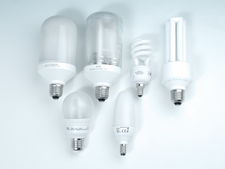-
Topics
subnavigation
Topics
Electromagnetic fields
- What are electromagnetic fields?
- Static and low-frequency fields
- Radiation protection relating to the expansion of the national grid
- High-frequency fields
- Radiation protection in mobile communication
Optical radiation
Ionising radiation
- What is ionising radiation?
- Radioactivity in the environment
- Applications in medicine
- Applications in daily life and in technology
- Effects
- What are the effects of radiation?
- Effects of selected radioactive materials
- Consequences of a radiation accident
- Cancer and leukaemia
- Genetic radiation effects
- Individual radiosensitivity
- Epidemiology of radiation-induced diseases
- Ionising radiation: positive effects?
- Risk estimation and assessment
- Radiation protection
- Nuclear accident management
- Service offers
-
The BfS
subnavigation
The BfS
- About us
- Science and research
- Laws and regulations
- BfS Topics in the Bundestag
- Links
Compact fluorescent lamps (energy-saving lamps) are safe to use under radiation protection aspects
- Compact fluorescent lamps are safe to use for general lighting purposes in the household under radiation protection aspects.
- Regardless of complying with limit values, the precautionary reduction of preventable exposures is a proven measure in radiation protection.
- The BfS recommends labelling lamps which also take account of precautionary radiation protection with, for example, the Blue Angel (RAL-UZ 151).

![]() Different types of fluorescent lamps
Different types of fluorescent lamps
Compact fluorescent lamps are safe to use for general lighting purposes in the household under radiation protection aspects. The existing investigations on the emitted optical radiation and the generated electric and magnetic fields indicate that - even when used at close distances - the exposure to the individual stays below the internationally recommended limit values for the protection of human health.
Some publications on the radiation from compact fluorescent lamps apply emissions criteria for evaluation which were drawn up for other product categories. One example is the criteria for low-radiation computer screens established by the Swedish Confederation of Professional Employees (TCO). The criteria for this comparatively low-radiation emitting product category are based on the idea of minimisation, though limited by the condition of being technically feasible for exactly this product group. The criteria are not directly related to health and - as far as technical feasibility is concerned - cannot be transferred to another group of products such as lamps without being tested. In Germany, criteria for lamps which are based on what is technically feasible have been drawn up by now (Blue Angel (RAL-UZ 151)).
As far as several characteristics relevant for radiation protection are concerned, there is only a slight difference between incandescent lamps and compact fluorescent lamps. With common fluorescent tubes, illuminants using a technology very similar to that of compact fluorescent lamps, have long been commercially available and used in households.
Proven measure in radiation protection: Reducing preventable exposures as a precaution
Regardless of complying with limit values, the precautionary reduction of preventable exposures is a proven measure in radiation protection. In the present case, precautionary recommendations are particularly justified by the following facts:
- UV radiation has been classified as carcinogenic (cancer-causing);
- even weak UV radiation can cause adverse health effects;
- health risks from electric and magnetic fields at frequencies in the kilohertz range have been much less investigated than risks from fields in other frequency ranges including the UV range; as a result there are additional uncertainties in the health risk assessment.
On account of general precautionary considerations and the facts mentioned above, lamps used in the household, for example, should only emit little electromagnetic radiation outside the visible wavelength range.
Considerable variation between different lamps regarding emitted radiation
Measurements carried out by the BfS and the limited data published by third parties show that the compact fluorescent lamps available on the market may vary considerably with regard to the radiation emitted outside the visible wavelength range even though international limit value recommendations are complied with. This observation also applies to lamps using other technologies.
For this reason, the BfS recommends that producers should label lamps which also take account of precautionary radiation protection as far as technically feasible, in a way that can easily be identified by consumers. A labelling that fulfils these requirements is, for example, the Blue Angel (RAL-UZ 151).
State of 2018.07.06


